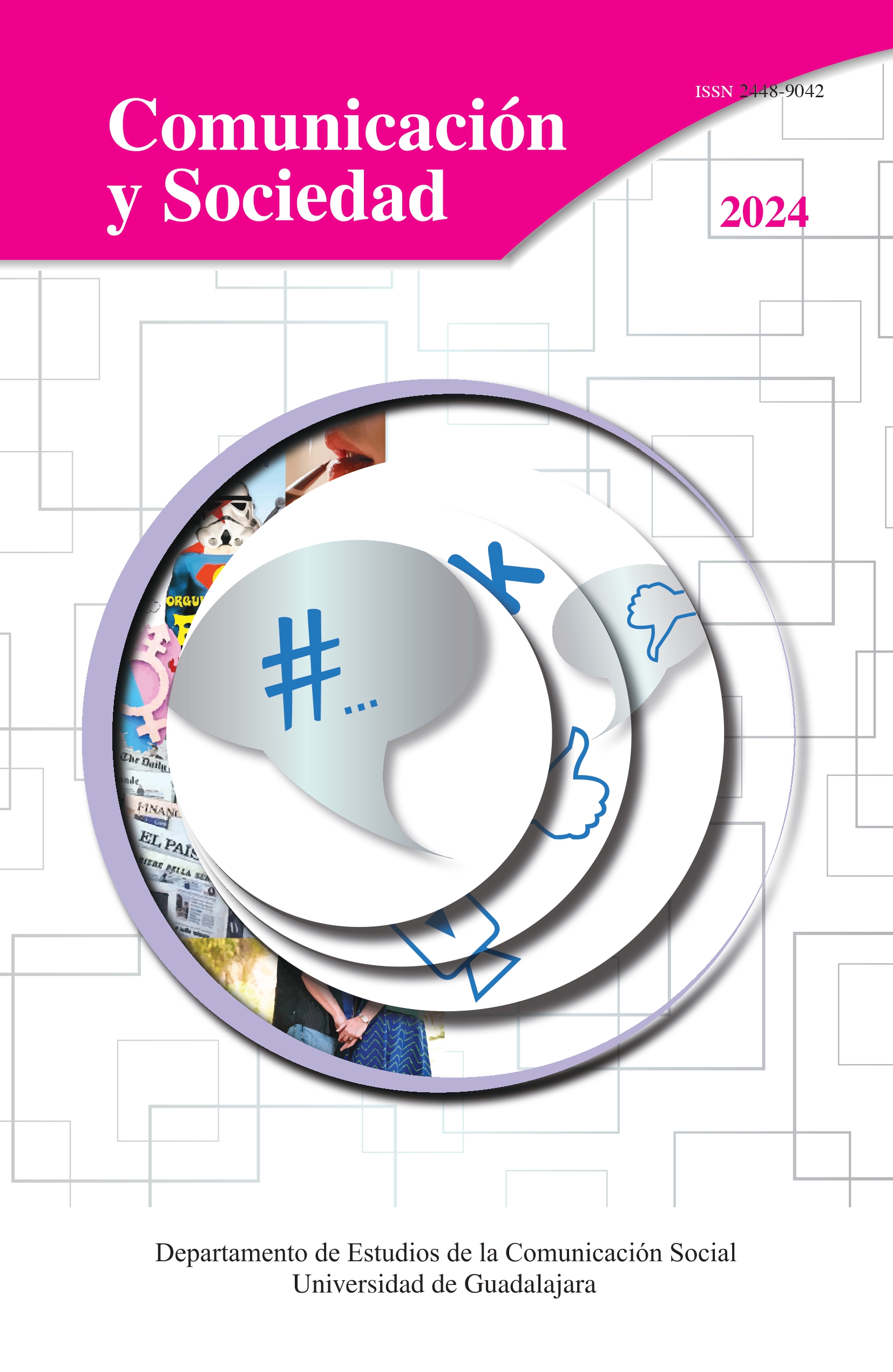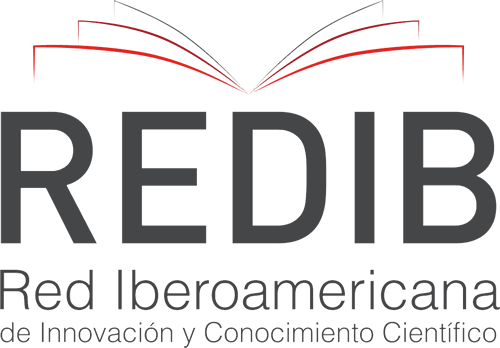La prensa española en TikTok: análisis de sus publicaciones
DOI:
https://doi.org/10.32870/cys.v2024.8644Palabras clave:
Análisis de contenido, Tiktok, Periodismo, Redes sociales, Videos de noticiasResumen
Esta investigación analiza la adecuación del contenido informativo que la prensa española está aplicando en TikTok. Con este objetivo, se aborda esta investigación desde un enfoque mixto. Por un lado, se ha llevado a cabo un análisis de contenido sobre 266 vídeos publicados por ocho diarios: cuatro periódicos tradicionales (El País, La Vanguardia, ABC y El Mundo) y cuatro diarios nativos digitales (20 Minutos, El Español, elDiario.es y El Huffpost). Estos hallazgos alcanzados mediante un análisis cuantitativo se complementarán con entrevistas semiestructuradas a los responsables de los medios analizados.Descargas
Citas
Agirreazaldegi, T. (2018). Documentación del material audiovisual de programas informativos en la televisión digital. Documentación de las Ciencias de la Información, 41, 73-83. https://doi.org/10.5209/DCIN.61457
Alley, A. & Hanshew, J. (2022). A long article about short videos: A content analysis of U.S. academic libraries' use of TikTok. The Journal of Academic Librarianship, 48(6). https://doi.org/10.1016/j.acalib.2022.102611
Anderson, K. E. (2020). Getting acquainted with social networks and apps: it is time to talk about TikTok. Library hi tech news, 37(4), 7-12. https://doi.org/10.1108/LHTN-01-2020-0001
Ankuash-Kaekat, L., Peralta-Herrera, N. & Suquilanda, M. (2021). TikTok en el ocio de los jóvenes. En A. Torres-Toukoumidis, A. De-Santis & D. Vintimilla-León, TikTok: Más allá de la hipermedialidad, 1, 33-50. Universidad Politécnica Salesiana. http://dspace.ups.edu.ec/handle/123456789/21071
Ballesteros-Herencia, C. A. (2020). La propagación digital del coronavirus: midiendo el engagement del entretenimiento en la red social emergente TikTok. Revista Española de Comunicación en Salud, 171-185. https://doi.org/10.20318/recs.2020.5459
Baysal, S. (2014). Working with generations X and Y in generation Z period: management of different generations in business life. Mediterranean Journal of Social Sciences, 5(19), 218-229. http://dx.doi.org/10.5901/mjss.2014.v5n19p218
Beckett, C. & Mansell, R. (2008). Crossing boundaries: New media and networked journalism. ica Communication, Culture & Critique 2008, 1(1), 992-104. https://doi.org/10.1111/j.1753-9137.2007.00010.x
Bell, E., Owen, T., Brown, P. D., Hauka, C. & Rashidian, N. (2017). The platform press: How Silicon Valley reengineered journalism. The Tow Center for Digital Journalism. https://doi.org/10.7916/D8R216ZZ
Berelson, B. (1952). Content Analysis in Comunication Research. Free Press.
Bernal, A. I. (2009). Los nuevos medios de comunicación y los jóvenes. Aproximación a un modelo ideal de medio. Euroeditions.
Blanco, S. & Palomo, B. (2021). Journalistic rigor and consistency the keys to the success of Spanish journalists on YouTube. Estudios sobre el Mensaje Periodístico, 27(4), 1043-1051. https://doi.org/10.5209/esmp.78143
Bock, M. A. (2012). Newspaper journalism and videos: Motion, sound, and new narratives. New Media & Society, 14(4), 600-616. https://doi.org/10.1177/1461444811421650
Boczkowski, P. J., Mitchelstein, E. & Matassi, M. (2018). “News comes across when I’m in a moment of leisure”: Understanding the practices of incidental news consumption on social media. New Media & Society, 20(10), 3523-3539. https://doi.org/10.1177/1461444817750396
Boftsi, A. (2020). A content analysis of instagram influencers’ posts: The Relationship Between Nonverbal Visuals Features and Engagement Rate. Tilburg University.
Burgess, J. & Green, J. (2018). YouTube: Online videos and participatory culture. Communication & Society, 23(9), 1386-1387. https://doi.org/10.1080/1369118X.2020.1726989
Cerezo, P. (2016). La Generación Z y la información. Revista de Estudios de Juventud, 114, 95-109. https://goo.gl/d6LEPi
Chobanyan, K. & Nikolskaya, E. (2021). Testing the waters: Tik Tok´s potencial for television news. World of Media Journal of Russian Media and Journalism Studies, (3), https://www.doi.org/10.30547/worldofmedia.3.2021.3
Díaz-Lucena, A., Álvarez Monzoncillo, J. M. & Mora de la Torre, V. (2022). YouTube y el nuevo rumbo de la prensa española. Revista Latina de Comunicación Social, (80), 47-67. https://www.doi.org/10.4185/RLCS-2022-1549
Díaz-Lucena, A. & Mora de la Torre, V. (2022). Instagram, la nueva apuesta por el contenido audiovisual de la prensa española. Documentación de las Ciencias de la Información, 45(1), 71-81. https://doi.org/10.5209/dcin.78680
Reuters Institute. (2022). Digital News Report. https://reutersinstitute.politics.ox.ac.uk/es/digital-news-report/2022
Dimock, M. (2019). Defining generations: where Millennials end and Generation Z begins. Pew Research Center. https://pewrsr.ch/3B2nABG
Drapkin, A. (2022, 2 de marzo). TikTok extends videos length limit to 10 minutes. Tech.co. https://tech.co/news/tiktok-extends-video-10-minutes
Ekström, M. & Westlund, O. (2019). The dislocation of news journalism: A conceptual framework for the study of epistemologies of digital journalism. Media and Communication, 7(1), 259-270. https://doi.org/10.17645/mac.v7i1.1763
Forman-Katz, N. & Matsa, K. E. (2022, 20 de septiembre). News Platform Fact Sheet. Pew Research. https://www.pewresearch.org/journalism/fact-sheet/news-platform-fact-sheet/
Galán, L., Osserman, J., Parker, T. & Taylor, M. (2019). How Young People Consume News and the Implications for Mainstream Media: A Report by Flamingo Commissioned by the Reuters Institute for the Study of Journalism. Oxford University. https://acortar.link/SEF1Ej
García Rivero, A., Martínez Estrella, E. C. & Bonales Daimiel, G. (2022). TikTok y Twitch: nuevos medios y fórmulas para impactar en la Generación Z. Icono 14, 20(1). https://doi.org/10.7195/ri14.v20i1.1770
Ghaffary, S. (2022, 2 de febrero). Facebook is shrinking. Its total user base declined for the first time, putting more pressure on its big metaverse bet. Vox Media. https://lc.cx/iCfQXP
Hallgren, N. & Nylund, M. (2018). Online videos at newspaper websites: A literature review. The Journal of Media Innovations, 4(2), 71-79. https://doi.org/10.5617/jomi.v4i2.2339
Hermida, A. (2016). Social media and the news. En T. Witschge, C. W. Anderson, D. Domingo & A. Hermida, The sage Handbook of Digital Journalism (pp. 81-94). sage Publications. https://doi.org/10.4135/9781473957909
iab (2021) Estudio de Inversión Publicitaria en Medios Digitales 2021. https://iabspain.es/estudio/estudio-de-inversion-publicitaria-en-medios-digitales-2021/
Kalogeropoulos, A. (2017). Online news videos consumption: A comparison of six countries. Digital Journalism, 651-665. https://doi.org/10.1080/21670811.2017.1320197
Klug, D. & Autenrieth, U. (2022). Struggle for Strategy. Presence, Practices, and Communicative Strategies of Legacy News Providers on TikTok. MediArXiv. https://doi.org/10.33767/osf.io/m3ztq
Li, X., Xiaohu, Y. & Zhengwu, Z. (2019). “Research on the causes of the TikTok app becoming popular and the existing problems”. Journal of Advanced Management Science, 7(2), 59-63. http://dx.doi.org/10.18178/joams.7.2.59-63
Liedke, J. & Matsa, K. E. (2022, 20 de septiembre). Social Media and News Fact Sheet. Pew Research. https://www.pewresearch.org/journalism/fact-sheet/social-media-and-news-fact-sheet/
Malik, A. (2022, 28 de febrero). TikTok expands max videos length to 10 minutes, up from 3 minutes. TechCrunch. https://techcrunch.com/2022/02/28/tiktok-expands-max-video-length-to-10-minutes-up-from-3-minutes/
Masip, P., Micó, J. L. & Meso, K. (2012). Periodismo Multimedia en España. Análisis De los contenidos multimedia en la prensa digital. En III Congreso Internacional de la Asociación Española de Investigación de la Comunicación. Comunicación y Riesgo.
Mayoral, J. & Edo, C. (2015). Hacia una nueva narrativa audiovisual: análisis de cinco cibermedios españoles. Communication & Society, 28(1), 145-164. https://doi.org/10.15581/003.28.35973
Mellado, C. & Hermida, A. (2021). The promoter, celebrity, and joker roles in journalists’ social media performance. Social Media + Society, 7(1), 1-11. https://doi.org/10.1177/2056305121990643
Morales, F. (2011). Diseño de un modelo de construcción informativa audiovisual eficiente: una propuesta para la generación de efectos de sentido. E-Compós, 14(1). https://doi.org/10.30962/ec.471
Miao, W., Huang, D. & Huang, Y. (2021). More than business: The de-politicisation and re-politicisation of TikTok in the media discourses of China, America and India (2017–2020). Media International Australia. https://doi.org/10.1177/1329878X211013919
Ng, R. & Indran, N. (2022). Not too old for TikTok: How older adults are reframing aging. The Gerontologist, 62(8), 1207-1216. https://doi.org/10.1093/geront/gnac055
Olivares-García, F. J. & Méndez Majuelo, I. (2020). Análisis de las principales tendencias aparecidas en TikTok durante el periodo de cuarentena por la covid-19. Revista Española de Comunicación en Salud, 1. https://doi.org/10.20318/recs.2020.5422
Patel, K. & Binjola, H. (2020). Tik Tok the New Alternative Media for Youngsters for Online Sharing of Talent: An Analytical Study. ssrn. http://dx.doi.org/10.2139/ssrn.3600119
Pavlik, J. (2019). Journalism in the age of virtual reality: How experiential media are transforming news. Columbia University Press.
Paz-Enrique, L. E., Hernández-Alfonso, E. A. & Leiva-Mederos, A. A. (2020). Concepción, etapas y modelo del ciclo de vida de la información audiovisual. Cuadernos de Documentación Multimedia, 31, e68514. http://dx.doi.org/10.5209/cdmu.68514
Pellicer, M. (2019, 14 de julio). TikTok: Cómo puede ayudar a los medios de comunicación. Miquelpellicer. https://miquelpellicer.com/2019/07/tiktok-como-puede-ayudar-a-los-medios-de-comunicacion
Pérez-Seijo, S., López-García, X. & Campos-Freire, F. (2018). La aplicación de las narrativas inmersivas en los reportajes: Estudio de caso del diario español ‘El País’. En J. L. González Esteban & J. A. García Avilés (Coords.), Mediamorfosis. Radiografía de la innovación en el periodismo (pp. 61-78).
Pew Research Center. (2021, 7 de abril). Social Media Fact Sheet. En Pew Research Center. https://www.pewresearch.org/internet/fact-sheet/social-media/?menuItem=4abfc543-4bd1-4b1f-bd4a-e7c67728ab76
Rapkin, M. (2017, 1 de noviembre). The social media platform that has Gen Z obsessed. Wall Street Journal Magazine. https://on.wsj.com/2YVWhZj
Salb, S. F. (2021). # NewsOnTikTok: A content analysis of the use of text elements by legacy news media on TikTok. Malmö University Publications. http://urn.kb.se/resolve?urn=urn:nbn:se:mau:diva-47120
Schmidt, C. (2019, 18 de junio). Meet TikTok: How the Washington Post, nbc News, and The Dallas Morning News are using the of the moment platform. NiemanLab. http://bit.ly/2WsybF4
Shuai, Y., Yuzhen, Z. & Yifang, M. (2019). Analysis of the reasons and development of short videos application – Taking TikTok as an example. En 9th International Conference on Information and Social Science (iciss 2019) (pp. 340-343). Francis Academic Press.
Serra, J. (1996). Telediarios, una experiencia práctica. Instituto Oficial de Radio Televisión Española.
Scolari, C. (2020). Cultura snack. La Marca Editora.
Seymour, E. (2019, 25 de agosto). Gen Z about to change the face of the US. Voice of America. http://bit.ly/2LfVTBt
Struckmann, S. & Karnowski, V. (2016). News consumption in a changing media ecology: An mesm-study on mobile news. Telematics and informatics, 33(2), 309-319. https://doi.org/10.1016/j.tele.2015.08.012
Swasy, A. (2016). How Journalists Use Twitter: The Changing Landscape of U.S. Newsrooms. Lexington Books.
TikTok Team. (2022, 15 de diciembre). TikTok celebra 2022: un año verdaderamente #ParaTi https://newsroom.tiktok.com/es-es/resumen-de-2022-en-tiktok-espana
Turner, A. (2015). Generation Z: technology and social interest. The Journal of Individual Psychology, 71(2), 103-113. https://doi.org/10.1353/jip.2015.0021
Vázquez-Herrero, J., Negreira-Rey, M. C. & López-García, X. (2022). Let’s dance the news! How the news media are adapting to the logic of TikTok. Journalism, 23(8), 1717-1735. https://doi.org/10.1177/14648849209690
Vilanova, N. & Ortega, I. (2017). Generación Z. Plataforma Editorial.
Wang, Y. (2020). Humor and camera view on mobile short-form videos apps influence user experience and technology-adoption intent, an example of TikTok (DouYin). Computers in Human Behavior, 110. https://doi.org/10.1016/j.chb.2020.106373
Wang, Y. H., Gu, T. J. & Wang, S. Y. (2019). Causes and characteristics of short videos platform internet community taking the TikTok short videos application as an example. ieee International conference on consumer electronics, 1-2. https://doi.org/10.1109/ICCE-TW46550.2019.8992021
Zelizer, B. (2019). Why journalism is about more than digital technology. Digital journalism, 7(3), 343-350. https://doi.org/10.1080/21670811.2019.1571932
Zhu, Y. (2020). The Expectation of TikTok in International Media: A Critical Discourse Analysis. Open Journal of Social Sciences, 8, 136-148. https://doi.org/10.4236/jss.2020.812012
Descargas
Publicado
Cómo citar
Número
Sección
Licencia

Esta obra está bajo una licencia internacional Creative Commons Atribución-NoComercial 4.0.
Los autores/as que publiquen en esta revista aceptan las siguientes condiciones:
De acuerdo con la legislación de derechos de autor, los autores conservan los derechos de autoría y otorgan a Comunicación y Sociedad el derecho de primera comunicación pública de la obra. Comunicación y Sociedad no realiza cargos a los autores por enviar y procesar artículos para su publicación.
Los autores/as pueden realizar otros acuerdos contractuales independientes y adicionales para la distribución no exclusiva de la versión del artículo publicado en Comunicación y Sociedad (por ejemplo incluirlo en un repositorio institucional o publicarlo en un libro) siempre que indiquen claramente que el trabajo se publicó por primera vez en Comunicación y Sociedad.











